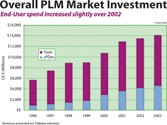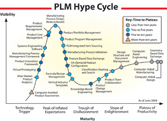Latest News
September 1, 2004
By Louise Elliott
A couple of years ago, DE turned to industry analysts for definitions of PLM.This time, we asked Ken Amann of CIMdata, Marc Halpern of Gartner, Monica Schnitgerand Tim Hickey of Daratech, and Ken Versprille of CPD Associates for their thoughtson the maturity of PLM technologies, their markets, predicted growth, and theiropinions on the most important trends today.
“Product lifecycle management (PLM) isn’t a new concept. Manufacturing companieshave been managing product lifecycles forever,” says Ken Versprille, partner andPLM research director for CPD Associates, formerly the PLM Group of D.H. Brownand Associates. “The old ways of doing PLM may not have been optimal, but theyworked. What industry needs to understand now is that modern PLM provides a setof tools, a framework to allow individual users to unite the internal organizationsthat contribute to the product lifecycle, and tie in the supply chain in support.”
How they do so will probably depend on the size of the enterprise, its geographicscope, the nature of its products, its dependence or lack of dependence on suppliers—andjust what it most wants to accomplish with PLM. The latter may vary from productportfolio development to tracking maintenance records, or all the way from initialconcept through obsolescence. As the concepts and supporting technologies forPLM mature, companies can choose from do-everything toolsets that require seriouspre-planning to deploy, to Internet-accessed or template-based systems that areready to go to work on less complex management tasks.
Market Maturity and Short-Term GrowthThe industry analysts generally agree that PLM has proved its value sufficientlyto enable growth for the future. “Some basic capabilities, such as data vaulting,have almost become commodities,” says Ken Amann, director of Research for CIMdata.He forecasts moderate growth in the PLM market over the next few years (see Figure1: below, right).

Figure 1: CIMdata predicts moderate growth in the PLM market through 2008. Anote on this slide: CIMdata defines cPDm as encompassing all of PLM except forinformation authoring tools such as MCAD and ECAD, computer-aided software engineering(CASE), and technical publishing. cPDm focuses on collaboration, management, andsharing of product-related information.
Marc Halpern, Research director, PLM, for Gartner, goes even farther, saying,“Microsoft’s Sharepoint will grow in use, and lead to dramatic declines in PDMpricing. This may hurt PDM-heavy PLM players such as MatrixOne and Agile, whichwill need to offer a broader framework for PLM.” In 2003, Halpern predicted moderategrowth for PLM in 2004, which seems accurate at this stage of the year. He alsopredicted that the enterprise PLM vendors, “Agile, IBM/Dassault Systemes, UGS,PTC, and MatrixOne, will continue to dominate the market. However, interestingniche vendors, such as Aras Corp. and Arena Solutions, have appeared and willhave growing influence, as will new models of on-demand services now being promotedby IBM.”
Daratech has a slightly narrower definition of PLM than the other analysis companies,limiting it to data creation (CAD/CAE/manufacturing process control), PDM, andWorkflow (see the sidebar, page X). Monica Schnitger, senior vice president ofmarket analysis, says, “Companies now trust PLM enough to change their businessprocedures. Vendors report strong pipelines, and more small to medium sized companiesare starting to adopt PLM.”
Tim Hickey, managing editor for Daratech publications, says that the recent businessslow-down gave companies time to plan pilot PLM studies. “People are getting excitedabout PLM even at the low end, as in the case of a company that recently switchedfrom 2D AutoCAD to Autodesk Inventor with data vaulting.”
Over the short term, Versprille expects technological advancement to move forward.“The technology has advanced, but it’s not finished. We’ll soon see the frameworkarchitectures completed and third party applications plug into them. Users willbe able to join up diverse data sources all over the enterprise and supply chain,and bundle it to create new data. They will link old and new data to get a newset of applications—though no one has yet defined what they will be, and broaderunderstanding will be needed to be able to work with multi-CAD, CAE, PDM and othertools,” he says.
PLM TrendsAmann points toward consolidations and new start-ups in the PLM field as trends,along with “larger and larger, as well as broader and broader deployment. Themost advanced installations are in automotive and aerospace applications, andthe next highest growth will be in electronics, high tech and packaged goods.”
In addition, he sees mid-sized companies making up a growing PLM market sector.“As more solutions come pre-packaged and pre-configured so that they can be installedand deployed more easily, cheaply, and faster, there will be more adoption.”
A mega-trend, says Halpern, will be narrowing of the fields that offered opportunitiesa few years ago. “We used to talk about PLM, ERP, SCM (supply chain management),and CRM (customer relationship management). PLM and ERP will be the last two toremain standing. SCM and CRM will be marginalized or absorbed into the others.”
Gartner has done a series of studies called Hype Cycles to describe the maturityof a variety of different application areas. “Every new software technology goesthrough phases we call technology trigger, peak of inflated expectancy, troughsof disillusionment, slope of enlightenment, and plateau of productivity. PLM mapswell against CAD: growth, crash, and greater penetration of mid-range tools, butthe various technologies go through maturation curves at different rates.”
The Gartner chart shown here shows how the various PLM technologies have gonethrough their maturation curves, along with the anticipated time it will takefor each to mature.
Single Source or Mix And Match?Although large companies with existing substantial investments in software fromone or another of the single source PLM vendors (and SAP, which is growing itsshare of the PLM market, especially with users of its MRP and ERP systems) tendto go for a single source of all tools, most of the analysts recommend moves towardinteroperability.
“The big vendors push single source solutions, while obviously, those with pointsolutions don’t,” says Schnitger. “The choice depends on the what the buyer wantsor already has in-house, and whether he wants all his eggs in one basket. It’seasier to mix and match if UGS systems are the basis, because they are prettyopen. PTC is a little less so, and Dassault Systemes insists on V5 architecture.”
She points out that going with a single provider can cause supply chain friction.“An area of growth will clearly be in enabling communication tools between PLMsystems,” she says. “Of course, if a small company comes up with a solution, itwill probably be gobbled up by a big player.”
A tool that may help communication, if not interoperability, is XML. Versprillesays that XML will help because it makes interfacing easier. “But it’s not a cure-all.And although there may be advantages to having a single source closed system throughbuilt-in coupling of capabilities, you can’t use the solutions you already havewith such systems.”
For example, he points out, a company may use Dassault’s CATIA and DELMIA forCAD and manufacturing process planning, but may already have an installation ofTeamcenter from UGS for data management and collaboration. “Big companies havemultiple supply chains that use heterogeneous systems that need to communicate.Vendors now need to write simple enough tools so that companies don’t have todo a great deal of bridging programming. They need to help users get the systemsup in a day and make the extra work go away. The future for PLM openness dependson development of Web-based services and XML data granularity.”
CPD Associates is currently trying to come up with a definition of the issues—addinga new tool for potential users to judge solutions. This will join Gartner’s MagicQuadrant and Hype Cycles, along with the comparative tools made available by Daratechand CIMdata, among others.
Pain points still remain. Halpern says that all the developers will have to addressremaining pain issues felt by users and answer their questions: How do you deploythis? How can you phase deployment so that you get ROI at each step? And the developershave their own pain issues: interoperability, modularity or non-modularity, datasharing, data hand-offs to financial departments. How can they handle the sheervolume of data? New tools will be needed, “such as compression capabilities from (products) such as Lattice3D (from Lattie Technologies USA),” he says.
“PLM tools are very promising,” says Versprille. “They already help on the supplychain side for ordering and order fulfillment. They bring in the business andfinancial sides of organizations, and sales, marketing, and services. Everyoneneeds to remember that PLM is broader than integration of design and manufacturing,and one size does not fit all.”
Contributing editor Louise Elliott is a freelance writer based in California. Offer Louise your feedback on thisarticle by clicking here. Please reference “PLM Maturing” in your message.
PLM and the Manufacturing Enterprise
If you ever wondered why you cannot keep all the systems that make up your company’sof your IT management structure straight, this slide from Daratech probably providesa visualization of the answer. But it is not as complicated in concept as it mightseem. First, though you have to draw the distinction between PLM (product lifecyclemanagement) and ERP (enterprise resource planning).
As Tim Hickey of Daratech explains it, the main difference between PLM and ERPsystems is that ERP is driven by the need for management visibility and controlover enterprise activities in terms of their financial impact. PLM is about product.PLM’s objectives are twofold: to accelerate time to money and to promote innovationat both the product and process levels.
A PLM deployment includes data authoring and management tools like MCAD, CAM,CAE, PDM, document management, BOM, and digital manufacturing process management(DMPM). To maximize the benefit of such a system, these tools must interface withother enterprise applications, most importantly ERP, and including supply chainmanagement (SCM), customer relationship management (CRM), manufacturing resourceplanning (MRP), and the like.
Additionally, PLM is evolving to include links to HR, Inventory Control, Purchasing,and Finance.—DE Editors

Gartner’s Hype Cycle to describe the maturity of a variety of different applicationareas. Here, the various technologies that make up PLM and their anticipated timeto maturity are projected.
Subscribe to our FREE magazine, FREE email newsletters or both!
Latest News
About the Author
DE’s editors contribute news and new product announcements to Digital Engineering.
Press releases may be sent to them via [email protected].






